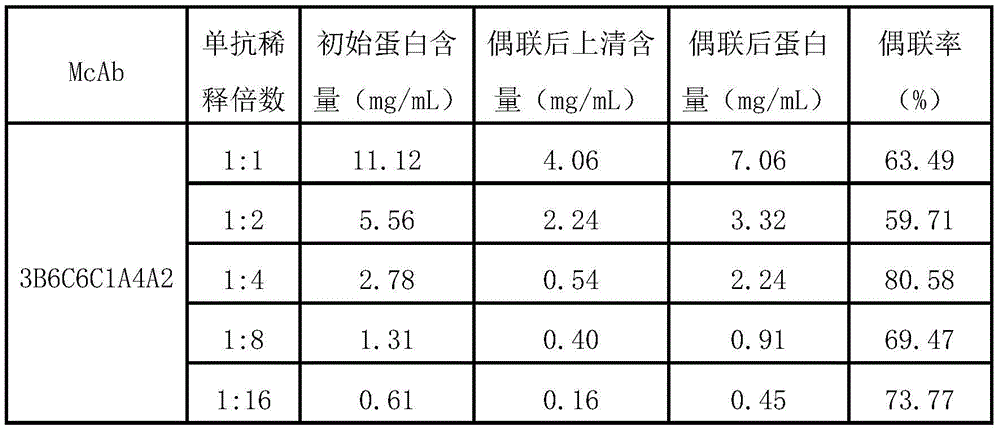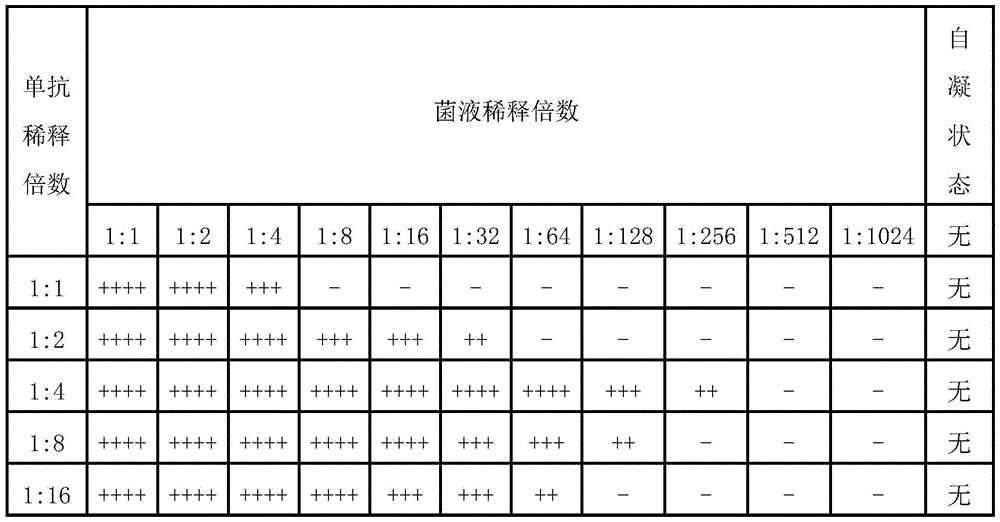A kind of enterohaemorrhagic Escherichia coli o157:h7 latex agglutination detection kit and its application
A detection kit, Escherichia coli technology, applied in the field of poultry immunology, can solve the problems of difficulty in product development, low stability and sensitivity, and achieve the effects of short detection time, strong specificity and simple operation
- Summary
- Abstract
- Description
- Claims
- Application Information
AI Technical Summary
Problems solved by technology
Method used
Image
Examples
Embodiment 1
[0018] Embodiment 1 Preparation of anti-enterohaemorrhagic Escherichia coli O157: H7intimin protein monoclonal antibody sensitization latex reagent
[0019] The preparation method of the anti-Intimin protein monoclonal antibody is as follows: from the 5 strains of hybridoma cells that have been established, one hybridoma cell with high antibody titer and strong specificity is selected for expansion and culture, and at the same time, it is induced in BALB / c mice. Mouse ascites produced monoclonal antibodies; 20 8-week-old BALB / c mice were injected intraperitoneally with incomplete Freund's adjuvant 0.5mL / mouse, and 7 days later, the expanded cultured hybridoma cells were injected intraperitoneally with 5×10 6 ~5×10 7 / mouse, feeding observation, when the abdomen of the mouse protrudes and the movement is sluggish, the ascites of the mice is extracted one by one, centrifuged at 2000r / min for 8min, the fat is discarded to collect the upper layer to clarify the ascites, and the as...
Embodiment 2
[0042] The using method of embodiment 2 enterohaemorrhagic Escherichia coli O157:H7 latex agglutination detection kit
[0043] 1. Sample processing: put the collected sample to be tested in the sample processing solution and incubate at 37°C for 4-6 hours.
[0044] 2. Detection of tested samples: 1) Add 10 ul of positive control sample, 10 ul of negative control sample and 10 ul of sample to be tested dropwise on a clean glass slide or glass plate. Then add 10 ul of the latex detection reagent dropwise to the positive control sample, negative control sample, and sample to be tested, stir evenly, and observe the result under a blue background after shaking for 1 minute. 2) Judgment of results: The test can only be established if the following results appear within 1 minute of the control test: latex agglutination of more than +++ occurs between the positive control sample and the latex detection reagent, and no agglutination between the negative control sample and the latex det...
Embodiment 3
[0046] Example 3 Preliminary Application of Enterohaemorrhagic Escherichia coli O157:H7 Latex Agglutination Detection Kit
[0047] 1. Sensitivity test: Pick a single colony of enterohemorrhagic Escherichia coli after cultured at 37°C for 18-24 hours on a Sorbitol MacConkey plate, culture it in 5 mL TSB liquid medium for 18-24 hours, and count the bacteria by plate counting method. And the bacterial solution was diluted in different gradients, and the OD of the bacterial solution was detected by a spectrophotometer 600 value, and then detected with a good latex reagent for sensitization (test results are shown in Table 7). Test results: the bacteria solution was diluted to 1:256 times (bacteria quantity 2.3×10 7 CFU / ml), there can still be obvious agglutination, and the test results show that the sensitivity is better.
[0048] Table 7 Sensitivity Test
[0049]
[0050] 2. Specificity test: Carry out latex agglutination detection with pathogens such as Salmonella, other s...
PUM
 Login to View More
Login to View More Abstract
Description
Claims
Application Information
 Login to View More
Login to View More - R&D
- Intellectual Property
- Life Sciences
- Materials
- Tech Scout
- Unparalleled Data Quality
- Higher Quality Content
- 60% Fewer Hallucinations
Browse by: Latest US Patents, China's latest patents, Technical Efficacy Thesaurus, Application Domain, Technology Topic, Popular Technical Reports.
© 2025 PatSnap. All rights reserved.Legal|Privacy policy|Modern Slavery Act Transparency Statement|Sitemap|About US| Contact US: help@patsnap.com



